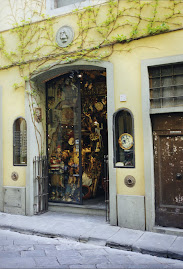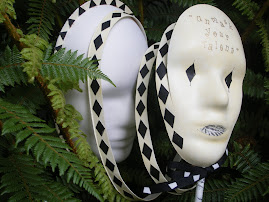 Recently I went to hear an African storyteller at our local library. From the moment she entered the room her strong presence was palpable. She seemed scarily powerful, even when the microphone stopped working and she had to rely on her own voice. She used no props other than a stick which she banged like a percussion instrument on a wooden floorboard. She wore no costume but when she changed character her face instantly became a 'mask' and she was... an old man, insect, wind, bird, anything, anyone... You could hear a pin drop during the telling of these tales resonant of African slavery and moral tales originally told to keep children safe.
Recently I went to hear an African storyteller at our local library. From the moment she entered the room her strong presence was palpable. She seemed scarily powerful, even when the microphone stopped working and she had to rely on her own voice. She used no props other than a stick which she banged like a percussion instrument on a wooden floorboard. She wore no costume but when she changed character her face instantly became a 'mask' and she was... an old man, insect, wind, bird, anything, anyone... You could hear a pin drop during the telling of these tales resonant of African slavery and moral tales originally told to keep children safe. This session was in stark contrast to one I attended the evening before. At our local university I attended an inaugural professorial lecture about 'higher education', a shambollic 'storytelling' event where the speaker wore full academic costume, had full IT support (the microphone, etc worked!!) with a banquet waiting upstairs (could have fed the whole of Ethiopia), but who lost the audiences attention with his pompous whitterings.
The two speakers couldn't have been more different! Authenticity requires no costume...
While studying African Primal Religions I came across a paper on Makishi, which is a celebration of masquerade or mask-wearing among the Mbunda people of Zambia (makishi being the plural form of likishi, the mask itself). In this region of Africa it was observed that the men wore masks but when women performed the makishi dance they did not. Early anthropologists had made the assumption that masks were restricted to menfolk because they were "too powerful" for womenfolk to handle.
Disputing this male power argument the female author claimed that early anthropologists had asked the wrong question; the issue at stake was not who owned or performed in the masks, but who in the community knew the proper response (to the masks). And by responding appropriately to the cast of makishi characters the women, she argued, acted out a kind of diplomacy in motion, the ‘glue’ necessary for community cohesion. What really informs your status - as medicine man, shaman or modern storytelling equivalent – is not what you wear... but the way others react.
Two words help define a “Maskerpiece”: depth and power. The more critical thinking that goes into the design and construction (depth), the more likely there will be an evocative or provocative aesthetic response (power).
To make this Makishi Mask you will need:
One Ultra Multimask, scissors and sandpaper
Painting and sealing:
Gesso, black
Weaving:
String woven from coconut fibre (or equivalent), apply to rim and sides of mask
Hot glue gun, stick weaving on before polishing or else the fibre won’t stick well
Polishing:
Kiwi Shoe Polish, dark tan + soft rag to apply + brush
Adornment:
Textile strips
Two handmade beads (available from bead store)
Mark-making:
Ash (from firebox), wipe on with fingers, sometimes the simplest of details is the most stunning.
Finishing touches:
Key (a 'Trickster' symbol)
Small ‘bee’ beadling (symbolising Queen Bee, or Africa as Mother of Masks)
Sometimes when you are making a composition, you don’t know why some symbols (like keys and bees) work well together, you just know it fits so if it makes your eyes happy, run with it.
Painting and sealing:
Gesso, black
Weaving:
String woven from coconut fibre (or equivalent), apply to rim and sides of mask
Hot glue gun, stick weaving on before polishing or else the fibre won’t stick well
Polishing:
Kiwi Shoe Polish, dark tan + soft rag to apply + brush
Adornment:
Textile strips
Two handmade beads (available from bead store)
Mark-making:
Ash (from firebox), wipe on with fingers, sometimes the simplest of details is the most stunning.
Finishing touches:
Key (a 'Trickster' symbol)
Small ‘bee’ beadling (symbolising Queen Bee, or Africa as Mother of Masks)
Sometimes when you are making a composition, you don’t know why some symbols (like keys and bees) work well together, you just know it fits so if it makes your eyes happy, run with it.




No comments:
Post a Comment